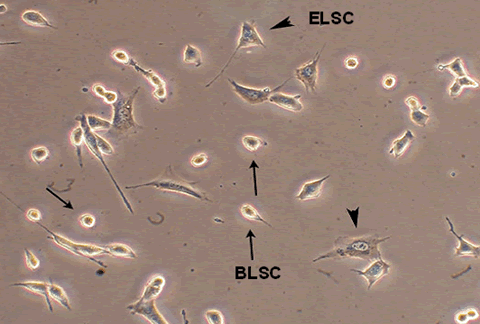Stem Cell Comparison: Embryonic versus Adult Stem Cells
In November 1998, Dr. James Thomson, from the University of Wisconsin, reported in Science his results for successfully propagating human embryonic stem cells in a petri dish. Thomson's groundbreaking results provided scientists the tools to routinely propagate human embryonic stem cells in their undifferentiated state. These embryonic cells were derived from a ball of cells called the blastocysts. The blastocyst consists of a hollow cavity formed during the 4th to 5th day of embryonic development. Embryonic stem cells used for research are taken from the inner cell mass found within the hollow cavity of the blastocyst (also see http://stemcells.nih.gov/info/basics).
The prevailing opinion among scientists is that adult stem cells are derived from tissues formed after birth. It is also believed that adult stem cells are limited in their ability to differentiate into various tissues of the body. Although there have been data supporting the principle that adult stem cells have properties very similar to cells found during embryonic development, the data appear controversial because it was difficult to reproduce the same results in different laboratories. However, much of the controversy revolves around the inability to grow a clonal population of adult stem cells that has been well characterized and studied for their potency or functionality. The technical hurdles facing adult stem cell scientists are the lack of special cell culture media to propagate a homogenous population of cells. However, Moraga's scientists have developed serum-free defined tissue culture reagents that allow scientists to be able to isolate, propagate, and clone various populations of adult stem cells.
The table below compares the difference between embryonic and adult stem cells. It also clarifies some of the issues and misinformation currently being disseminated to the public.
| Tissue Cultures | Embryonic | Adult-Derived |
|---|---|---|
| Growing Cells in Tissue Cultures in the presence of serum | Yes. Requires the addition of special growth and anti-differentiation factors | Yes. Requires the addition of special proliferative, anti-differentiation, and growth factors. |
| Serum-free Cultures | Mixed results. Unconfirmed reports in the literature using special growth factors and matrices. | Yes. With Moraga's proprietary culture media. |
| Differentiation in Cultures | Spontaneous differentiation & difficult to control when growing in cultures. Can differentiate into all tissue lineages of the body. | Requires special factors to induce cells to differentiate. Can differentiate into all tissue lineages of the body. |
| Establishing Cell Lines | Yes. Most human cell lines before August 2001 are contaminated. | Yes. Cloned lines with Moraga's special serum-free conditioned media. |
| Implantation | Forms teratomas when undifferentiated cells are implanted. Need to generate progenitors before implantation. | Does not form teratomas or other neoplastic tissues. Once activated, naive stem cells easy to integrate with surrounding tissues. Once differentiated, more difficult to integrate with surrounding tissues. |
The below photomicrograph shows two distinct population of adult stem cells grown in culture by Moraga's scientists. The Company's BLSC (arrows) that can eventually differentiate into epiblastic-like stem cells (ELSC-arrowheads) when grown under appropriate culture conditions. The ELSCs were also discovered by Company's scientists to be pluripotent adult stem cells that are downstream in development from the BLSCs. In the lower right-hand corner, the ultra small BLSCs appear to be dividing.

